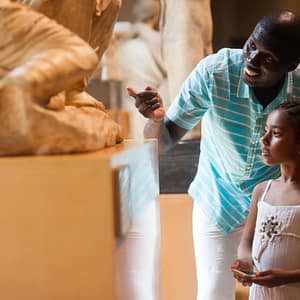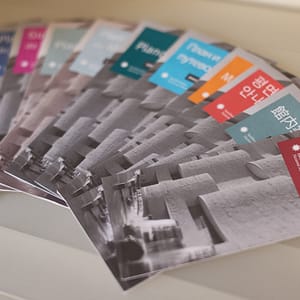Accessible & Inclusive Museums—How Small Measures Add Up
Issues related to accessibility, inclusion, and diversity are taking a forefront as museums seek out new ways to accommodate people with different needs. All institutions must, of course, comply with ADA guidelines. However, a stronger, more robust approach to inclusion requires taking a comprehensive look at the ways spaces can be made accessible to all visitors, regardless of disability, identity, or background.
Initiatives to improve equal access may require time, staff, and funding. But scalable, incremental efforts can form the basis for widespread inclusion. In this article, we look at some of the ways museums are using accessibility resources to include the widest possible audiences, and merging traditional efforts with language access. By considering the full range of diversity, your museum can enable more people to engage holistically with your offerings.
Promoting Equal Access and Inclusion in Museums
Making an institution welcoming to as many people as possible means removing barriers. We all have our own way of visiting a museum and interacting with content. To design an experience that reflects society’s pluralism, a museum must consider all the different ways visitors may participate.
Initiatives include:
- Quiet hours, social scripts, and sensory-friendly resources (noise-reducing headphones, fidget toys) for individuals on the autism spectrum
- Tactile exhibits and multisensory tours for the blind and visually impaired
- 3D printing to make touchable replicas of paintings
- Braille, large print, and tactile versions of museum floorplans and exhibition text
- ASL programs and tours for the deaf and hearing impaired
- Real-time captioning for events such as lectures and presentations
- Closed-captioned films with transcripts
- Assistive listening devices
- Activities, discussions, and art-making sessions for individuals with Alzheimer’s
- Family workshops for visitors with developmental or learning disabilities
- Barrier-free entrances/exits and access to galleries
- Wheelchairs and canes available for visitor use
- Themed tours and workshops for veterans
- Off-site programs for residents of nursing homes and retirement centers
- Disability awareness training to educate staff about best practices for assisting visitors
This is hardly a comprehensive list—and there are so many exciting initiatives that warrant more description. Here are a few:
The Smithsonian American Art Museum holds twice-monthly America InSight verbal description tours for visitors who are blind or have low vision. Led by specially trained docents, these interactive tours help visitors learn about the collection through rich verbal descriptions and sensory experiences.
The Whitney Museum introduced video blogs (vlogs) featuring deaf museum educators communicating in American Sign Language (ASL). The vlogs focus on topics in contemporary art or exhibitions past and present at the museum.
The Canadian Museum of Human Rights (CMHR) made inclusion a priority from the start. When still in its development phase, the museum set up an Inclusive Design Advisory Council comprising nine experts, advisors, and activists in the field of disability rights. One of the museum’s many inclusive features is the CMHR mobile app, which offers a fully accessible self-guided tour, using American Sign Language (ASL) and Langue des signes québécoise (LSQ), audio, images, text, and video. Using Bluetooth iBeacons, the app communicates with more than 120 Universal Access Points located throughout the museum—the first such use of this technology in Canada, and the largest installation in the world. The app also includes an interactive visitor “mood meter” that lets visitors share how they feel as they move through the Museum’s spaces. This feature—a first for any museum in the world—provides useful feedback about the visitor experience.
Let’s Chat!
Get in touch to speak with a member of our team.
Increasing Access for Non-English Speakers
Language access doesn’t always get addressed in the larger discussion about accessibility. The U.S. is becoming more diverse–ethnically, culturally, and linguistically. Today, 20% of U.S. residents speak a language other than English at home, and that number continues to rise. When materials are available only in English, it means a large segment of the population cannot access the cultural benefits a museum provides, including education and access to information.
As it becomes more imperative that museums reflect a wider segment of society, many are embracing a multilingual approach. Following are a few ways museums can combine traditional accessibility resources with initiatives to improve language access. By layering efforts, museums can welcome broader audiences.
Captioning and Subtitling Multimedia Content
Captioning and subtitling can make video content more accessible to visitors, both in museum galleries and online. They are similar, but have different purposes.
Subtitling is the process of adding a film’s transcript to the screen, coinciding with the spoken dialogue. Museums may of course use English-language subtitles when source content is in another language, but also with English-language source material, for the following reasons:
- A film that is difficult to understand in a crowded gallery space.
- An alternative to headsets when a museum does not want audio in a gallery.
- Speakers with heavy accents.
Translated subtitles are commonly used to interpret the dialogue into another language. They enable non-English-speaking or English-as-a-second-language visitors to engage with film content in their preferred language.
Captioning is intended for individuals with hearing impairments. While subtitles include only dialogue, captions provide additional information such as sound effects or speaker identification. Closed captioning, which can be toggled on and off, is the most commonly used form for digital videos. Another option is open captioning, in which the captions cannot be turned off.
To make multimedia content fully accessible, it should include a transcript along with subtitles and captions. The video transcript is the text version of the video, which allows anyone who cannot access web audio or video to read the content.
How Audio Tours Increase Accessibility
Audio tours provide recorded spoken commentary, typically through a cell phone or other handheld device, offering narration and behind-the-scenes stories. They allow visitors the flexibility of experiencing an exhibit in their own way, at their own pace, while following their own path. When accompanied by transcripts with standard or large print, audio tours can offer accommodations for those who are hard of hearing, deaf, blind, or partially sighted. And when translated, the audio tours and transcripts make exhibits accessible to visitors in their preferred languages.
Audio tours can focus on select works from an institution’s permanent collection. They can also be created for specific exhibitions, in the language most appropriate to the content of the show or the demographics of the target audience.
The Metropolitan Museum of Art offers an impressive audio guide, consisting of more than 3,000 recordings, available in English along with nine other languages. In 2015, the museum conducted a survey that found that the audio guides were viewed positively by visitors. Almost all of the visitors who used the audio guide reported spending more time in front of the artworks and gaining a deeper understanding of what the artworks mean. Visitors who used an audio guide were exponentially more likely to report a better overall experience at the museum compared with those who chose not to use it.1
Featured Services
Learn more about…
Supporting Visually Impaired Guests With Audio Description
Museums are increasingly using audio description to help blind or visually impaired visitors access their collections. Audio description entails inserting concise, objective descriptions between portions of dialogue to help listeners understand important visual elements. For example, descriptions might communicate the appearance of an object, its size, shape, color, and texture, rather than focus on its history or authorship. Audio description can also be used to lead visitors through an exhibit.
Museums are incorporating audio description into planetarium presentations, audio tours, films, videos, arts performances, and theatrical productions. The descriptions are meant to augment the performance or presentation, not interfere with the content.
In a 1998 study, the American Foundation for the Blind found that the majority of people with visual impairments who had used audio description said they found it very helpful. They preferred using materials that had audio description over those that lacked it.
Expand Your Audience
Creating a welcoming and inclusive environment means offering people a choice. Providing a range of resources enables visitors to select the way in which they are most comfortable experiencing the museum.
It is of course hard to tackle everything at once and address every challenge. By implementing small measures, and finding ways to overlap traditional accessibility efforts with language access, a museum can create an inclusive environment in which all are welcome.
 Named to the 2024 Inc. 5000 list of fastest-growing companies and ranked among the world’s top 100 language service providers by CSA Research
Named to the 2024 Inc. 5000 list of fastest-growing companies and ranked among the world’s top 100 language service providers by CSA Research

